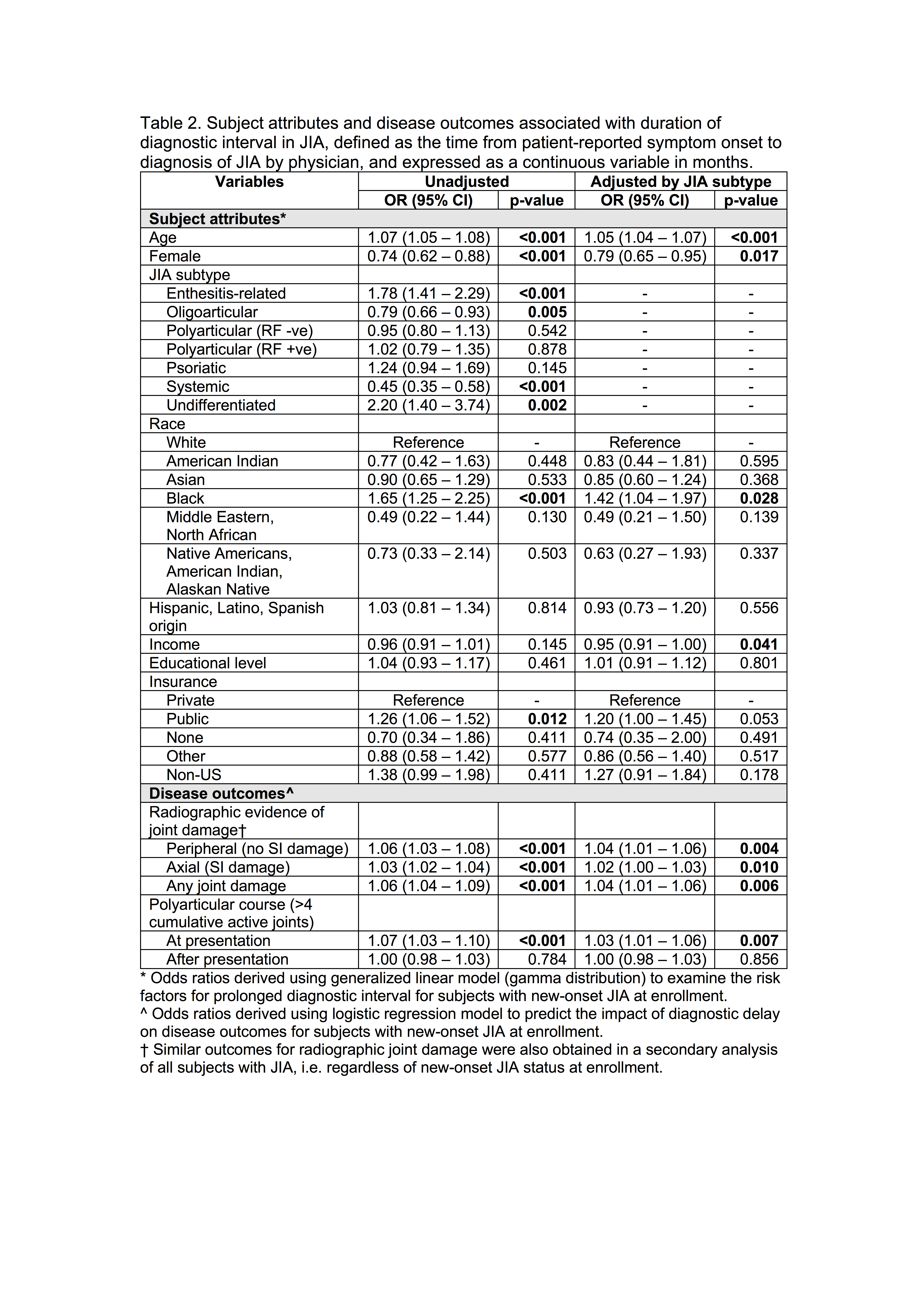Session Information
The 2020 Pediatric Rheumatology Symposium, originally scheduled for April 29 – May 2, was postponed due to COVID-19; therefore, abstracts were not presented as scheduled.
Date: Friday, May 1, 2020
Title: Poster Session 2
Session Type: ACR Abstract Session
Session Time: 5:00PM-6:00PM
Background/Purpose: While early treatment of patients with newly diagnosed juvenile idiopathic arthritis (JIA) is an area of active study, delayed diagnosis of JIA is poorly characterized, with no recently published data on such delays in JIA cohorts in North America. We analyzed the Childhood Arthritis and Rheumatology Research Alliance (CARRA) Registry to examine diagnostic delays in JIA, factors associated with delays, and impact of delays on select outcomes.
Methods: We performed a retrospective analysis of the CARRA Registry JIA cohort, focusing on subjects with new onset JIA who were enrolled in the registry within 6 months of JIA diagnosis and followed for ≥12 months (n=1195, enrollment years 2015-2018). We developed generalized linear models to identify factors associated with diagnostic interval (defined as the interval from self-reported symptom onset to physician-diagnosed JIA) and logistic regression models to examine the impact of this interval on risks of (1) radiographic evidence of joint damage and (2) progression to >4 joints involvement (polyarticular-course JIA).
Results: The median and mean time from symptom onset to JIA diagnosis were 3 months and 6.7 months, respectively. 31% of subjects (n=370) were diagnosed ≥6 months after symptom onset and 16% (n=189) were diagnosed ≥1 year after symptom onset (Table 1). As expected, diagnostic interval strongly correlated with duration from symptom onset to first pediatric rheumatology visit. Subjects with systemic JIA (sJIA) experienced shorter diagnostic intervals (OR 0.45; 95% CI 0.35-0.58; p< 0.001); longer intervals were observed among those with enthesitis-related arthritis (OR 1.78; 95% CI 1.41-2.29; p< 0.001) and undifferentiated JIA (OR 2.20; 95% CI 1.40-3.74; p=0.002). Older children, males, and individuals of black race experienced longer intervals (Table 2). Higher risk of development of radiographic joint damage was associated with longer diagnostic intervals (OR 1.06; 95% CI 1.04-1.09; p< 0.001). The risk persisted after adjusting for JIA subtype (OR 1.04; 95% CI 1.01-1.06; p=0.006), age, and sex. Longer diagnostic interval was also associated with a higher risk of polyarticular course at presentation (OR 1.07; 95% CI 1.03-1.10; p< 0.001) and persisted after adjusting for JIA subtype. When all subjects with JIA, i.e. not only thosewith new onset JIA at enrollment, were analyzed (n=3719), a diagnostic interval of ≥12 months (n=525) was associated with an increased risk (OR 1.09; 95% CI 1.04-1.15; p< 0.001) of radiographic joint damage in comparison to a diagnostic interval of 0-2 months, after adjusting for age, sex, and JIA subtype. This risk was greatest for sJIA (OR 1.34; 95% CI 1.03-1.72; p=0.028).
Conclusion: Individuals with JIA frequently experience intervals of months to years from symptom onset to initial diagnosis; these delays correlate with subsequent radiographic joint damage, an objective, long-term adverse outcome. While we acknowledge limitations of self-report of symptom onset and non-uniformity in obtaining joint radiographs, we believe our results nonetheless highlight the need for improvements in early recognition and referral of patients with suspected JIA to pediatric rheumatology care.
To cite this abstract in AMA style:
Ong M, Schiff G, Natter M. Incidence, Contributing Factors, and Impact of Diagnostic Delay in Juvenile Idiopathic Arthritis: Analysis of the Childhood Arthritis and Rheumatology Research Alliance (CARRA) Registry [abstract]. Arthritis Rheumatol. 2020; 72 (suppl 4). https://acrabstracts.org/abstract/incidence-contributing-factors-and-impact-of-diagnostic-delay-in-juvenile-idiopathic-arthritis-analysis-of-the-childhood-arthritis-and-rheumatology-research-alliance-carra-registry/. Accessed .« Back to 2020 Pediatric Rheumatology Symposium
ACR Meeting Abstracts - https://acrabstracts.org/abstract/incidence-contributing-factors-and-impact-of-diagnostic-delay-in-juvenile-idiopathic-arthritis-analysis-of-the-childhood-arthritis-and-rheumatology-research-alliance-carra-registry/


